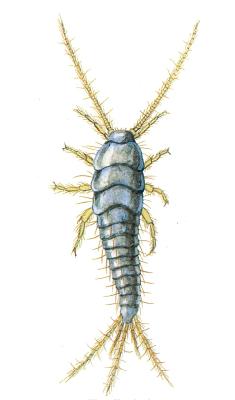Silverfish and firebrat

Silverfish (Lepisma saccharina) is a very common pest especially in humid conditions indoors. Therefore they can be e.g. found in sewers, kitchens, bathrooms and basements. They spread very easily from one apartment to another through pipeline and drains.
Where do silverfish come from?
Silverfish likes to eat starchy materials. They also damage cellulose. Therefore, bread crumbs and old books are especially in danger. In bathroom, loose hair and human skin are its favourites.
Silverfish enter your home e.g., thru small cracks and along with delivered furniture and objects. Whole apartment building can also be infested because they spread very easily in pipes and sewerage.
How to get rid from silverfish?
The best way to keep silverfish out is to keep damp areas such as kitchens and bathrooms as dry as possible, and to keep drains as clean as possible. It is also easier to dispose of sugar traps that have already entered the home in areas that can be dried and ventilated, for example with air conditioning. We can help you to control and eradicate silverfish. Contact us!
The firebrat thrives in the warmth conditions.
The firebrat (Lepismodes inquilinus) is a much rarer pest than silverfish, but it is still widespread in Finland. It requires a higher temperature than silverfish to live, but it also needs some moisture in its habitat. Oven larvae are usually found near heaters and ovens. We can help with oven mite control. Call us for more information!

Tunnistus
The silverfish is a silvery scaly pest about 1 cm long.
Firebrat, on the other hand, are a slightly larger pest than sugar worms. It is also much darker and has yellowish hairs on its sides.
Recently a new very similar species (Long-tailed silverfish, Ctenolepisma longicaudata) (linkki Wikipedia) has been located. Long-tailed silverfish is hairier, darker and also longer (body: 11 mm, total length: 40 mm) than silverfish.


Pest control of silverfish and firebrat
First, the situation is analysed and an individual prevention plan is drawn up for the site. This is followed by an effective and high-quality pesticide treatment.
We use a variety of methods to achieve the best possible results as quickly as possible. We also try to avoid the use of biocides as much as possible.
For more information on the control methods we use, please contact our pest controllers. Contact us!

Preparation
For more information (contact us)
Clear the floorboards of loose items – there is no need to move large objects or furniture such as bookshelves. Also empty the bottom of your wardrobes of clothes and the bottom of the kitchen sink of all belongings. Aquariums and the like should also be covered with cloth or blankets. In addition, their filter system must be switched off.
NOTE! Make sure that you let us in, or master key can be used. If you are not present, you should also make sure that your children and pets are away from your home during the treatment.
Thank you for your cooperation in advance!

Warning time
If needed (additional information will be provided beforehand)
Please note that after the pesticide treatment has been carried out, you and your pets are not allowed to enter your apartment before two (2) hours has passed by. Pregnant women, kids and people suffering from asthma shall stay away at least five (5) hours.

